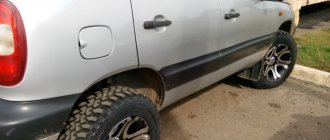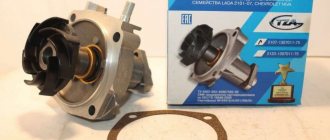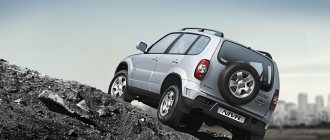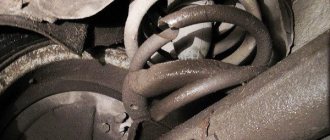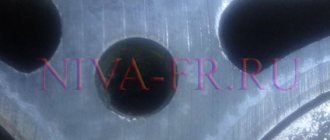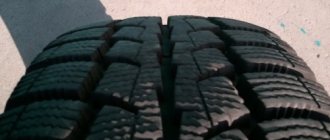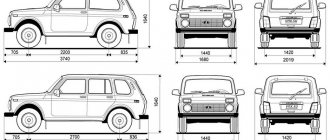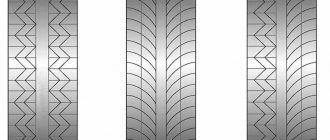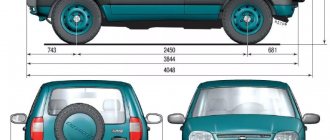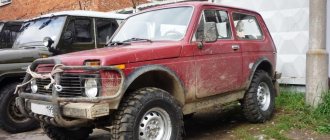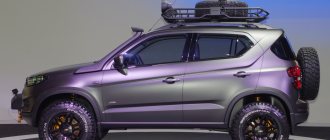Updated: 04/22/2021 15:09:39
Expert: Boris Evgenievich Kononov
*Review of the best according to the editors of expertology.ru. About the selection criteria. This material is subjective in nature, does not constitute advertising and does not serve as a purchase guide. Before purchasing, consultation with a specialist is required.
The Russian SUV Chevrolet Niva is highly popular among domestic motorists. One of the reasons for stable demand is high traffic. In addition, the machine is unpretentious in maintenance and has an affordable price. In order for a car to realize its full potential, it is important to choose the right tires. It is best to do this taking into account the time of year and the nature of the roads being overcome. With the help of our experts, we will try to determine the range of suitable tires.
Recommendations for choosing tires for the Chevrolet Niva
Manufacturer's recommendations
. Depending on the modification of the Chevrolet Niva, R15 or R16 wheels are installed on the factory assembly line. Therefore, before going to a car store, you should find out the equipment of your iron horse. The most common tire sizes are:
- 205/70R15;
- 205/75R15;
- 215/75R15;
- 215/65R16.
Seasonality
. For different times of the year, you should select seasonal “shoes” for the Chevrolet Niva.
- Summer tires behave well in the warm season, allowing the driver to enjoy a fast ride. It is quiet and has good rolling power.
- Winter tires are indispensable when operating a car on snowy or icy roads. Friction models are recommended for the southern regions of the country, and for northern routes it is better to prefer tires with studs.
- For those who like to ride through meadows and forests, special mud tires are recommended. It features an aggressive deep tread that is easy to clean off the ground. The only disadvantage of special tires will be noise on asphalt.
Speed and load index
. Many Chevrolet Niv owners use their cars as workhorses. Some reckless drivers are trying to set a speed record on paved highways. Therefore, when choosing tires, you should pay attention to the speed and load index.
- Speed characteristics are encrypted in letter designation (Latin letters). For example, “T” indicates a top speed of 190 km/h, and “V” allows you to accelerate to 240 km/h.
- The Chevrolet Niva can be seriously loaded, but only if you have the appropriate tires. The load index has a digital designation. If with the marking “60” the maximum weight per wheel is 250 kg, then with “113” this value will increase to 1150 kg.
We have selected the 14 best tires for the Chevrolet Niva for review. All models are sold in auto stores in our country. When distributing places, the editors of the journal expertology took expert opinions as a basis, taking into account the reviews of Russian crop farmers.
What tire sizes does the manufacturer recommend to install?
The choice of tires is a real problem for most Chevrolet Niva owners due to the fact that the “range of sizes” is limited. Driving for a long time on tires with inappropriate sizes leads to decreased vehicle control and emergency situations.
| Wheel disks | Tires |
| L, LG, GL 15 6Jx15 ET45 | 205/75R15 |
| GLC, LE, LE+ 16 6.5Jx16 ET44 | 205/70R15, 215/65R16 |
The abbreviation stands for as follows:
- wheel rim width;
- surface diameter;
- reach length;
- tire width;
- height in percent;
- diameter of the metal rim.
The higher the disc is installed on the car, the greater the risk of skidding and reduced control efficiency. At the same time, excessively low wheels also negatively affect ground clearance, lower ground clearance, and limit the vehicle’s maneuverability.
Rating of the best tires for Chevrolet Niva
| Nomination | place | Name of product | starting price |
| The best winter tires for Chevrolet Niva | 1 | Dunlop Grandtrek Ice02 | 4 428 ₽ |
| 2 | Hankook Tire i*pike RW11 | 4 000 ₽ | |
| 3 | GOODYEAR Ultra Grip Ice Arctic SUV | 6 326 ₽ | |
| 4 | Nokian Tires Nordman 7 SUV | 5 396 ₽ | |
| 5 | Bridgestone Blizzak DM-V2 | 5 500 ₽ | |
| 6 | Viatti Bosco Nordico V-523 | 3 152 ₽ | |
| The best summer tires for Chevrolet Niva | 1 | Yokohama BluEarth-Van RY55 | 4 170 ₽ |
| 2 | Continental CrossContact ATR | 6 095 ₽ | |
| 3 | Nokian Tires Nordman SX2 | 2 020 ₽ | |
| 4 | MICHELIN Latitude Cross | 5 000 ₽ | |
| The best mud tires for Chevrolet Niva | 1 | Toyo Open Country A/T plus | 3 875 ₽ |
| 2 | Continental ContiCrossContact AT | 5 099 ₽ | |
| 3 | GOODYEAR Wrangler All-Terrain Adventure With GOODYEAR | 6 750 ₽ | |
| 4 | Kumho Road Venture M/T KL71 | 8 840 ₽ |
What size winter tires should I use?
Winter wheels must not only cope with difficult conditions of icy or snowy roads, but also be suitable for the standard size of the car. The design of the Chevrolet Niva allows you to install tires with diameters of 15 or 16 inches. At the same time, such standard sizes as 195/70, 205/75, 205/70 or 185/75 are suitable without lifting.
R15
Despite the fact that the manufacturer in its recommendations gives preference to 16-inch wheels, it still allows for the possibility of installing products designed for R15 wheels, which can be found more often on the market. The most suitable sizes with this diameter are 195/70/R15, 205/75/R15 and 205/70/R15. In them, manufacturers offer a fairly large number of models to choose from at not very high prices.
It is worth highlighting the following products with spikes:
- Amtel NordMaster;
- Viatti Vettore Inverno;
- Kumho WinterCraft ice;
- Cordiant SnowCross.
- Nexen Winguard WinSpike;
- Matador MP 30;
- Jislevd NordFrost 100;
- Yokohama F700Z;
- Yokohama IceGuard IG35;
Tires with treads without studs, designed for winter roads, are also presented:
- Toyo Observe Gsi-5;
- Tunga Nordway;
- Viatti Vettore Brina;
- Kumho KW 7400;
- Nexen Winguard ice;
- Yokohama IceGuard IG 30;
- Sava Eskimo Ice;
- Nokian Nordman RS;
- Dunlop Graspic DS3.
In addition to these models from the budget and mid-price segments, manufacturers are able to offer car owners a fairly large list of specialized wheels at a more expensive price.
The poorest selection of tires is for size 205/75/R15, which, at the same time, is indicated by the manufacturer as a standard option. In fact, the domestic brand Cordiant is a monopolist in this segment. Its wheels are inexpensive, but still many Niva owners prefer to replace them with something else.
R16
Exactly 16 inches is the standard radius or, more precisely, diameter for Chevrolet Niva tires. The manufacturer installs the standard size 185/75/R16 on the car. The problem with such tires is that they are both narrow and high, so companies do not often undertake the production of such models, especially in the winter version.
Most wheels for the cold season with these sizes are made with studs. They are also the most popular among SUV owners in general. The stock option for the Chevrolet Niva is Voltyre VLI-5 and VLI-10 - they are inexpensive and easily accessible. But they do not have the best driving characteristics. Because of the latter, most car owners strive to replace them with something else at the first opportunity.
Among the popular studded substitutes, there are the following models that fully comply with the instructions of the Niva manufacturer:
- Amtel K182A Seven Hills;
- Nordman Nordman 4;
- Cordiant Business;
- Good Year Cargo Ultra Grip;
- Jisleivd NordFrost Van;
- Michelin Agilis X-ice North;
- Nokian Hakkapeliita.
Since studded tires are not always needed, models without studs on the tread are also available on the market:
- Rosava LTW;
- Amtel Seven Hills;
- Viatti Vettore Brina;
- Nokian WRC3;
- BelShina Bravado;
- Kama Euro 519;
- Hankook Winter Ipike;
- Tigar Cargo Speed;
- Yokohama W.Drive;
- Continental VanContact.
The budget category of the listed products includes those produced by the Russian brands Cordiant, Kama and Amtel, as well as the Belarusian BelShina and the Ukrainian Rosava. The increased price of most of these tires is one of the main reasons why car owners prefer 15-inch ones. There is simply more choice of the latter at an affordable price. There will also be a larger assortment in other price categories.
The best summer tires for Chevrolet Niva
From spring to autumn, it is best to drive a Chevrolet Niva on summer tires. Especially when the daily route runs along city streets or country roads. Experts liked the following tire models.
Yokohama BluEarth-Van RY55
Rating: 4.9
Summer tires Yokohama BluEarth-Van RY55 are designed for use on commercial vehicles, crossovers and SUVs. The element of rubber is city streets and country roads. In such conditions, the tires feel confident on both dry and wet asphalt. Experts note fuel efficiency, which should please Chevrolet Niva owners. Japanese designers worked out the tread pattern in detail, this made it possible to increase directional stability and reduce rubber deformation in the transverse direction. Domestic motorists also express their solidarity with the experts, making the model the winner of our review.
The main advantages of tires, according to users, are softness, wear resistance, and good balancing.
Advantages
- directional stability;
- affordable price;
- resistance to transverse deformation;
- fuel efficiency.
Flaws
- not detected.
Continental CrossContact ATR
Rating: 4.8
A successful balance between the main performance qualities allowed the Continental CrossContact ATR summer tires to win silver in our review. German tires are designed for crossovers and SUVs. The tread pattern has an unusual look for the brand. In the center there is a large number of blocks, united in groups of threes. They are responsible for directional stability and excellent traction and grip properties. If the central part is flexible, then the shoulder areas have a rigid connection. This structure increases efficiency during acceleration, maneuvering and braking.
Positive assessments prevail in reviews of Russian consumers. Car enthusiasts like tires for their versatility, noiselessness, and tenacity. The downside is the high price.
Advantages
- good handling;
- noiselessness;
- effective braking;
- resistance to aquaplaning.
Flaws
- high price.
How the pressure sensor works, how to turn it off on a Chevrolet Niva
The main task of the controller is to monitor changes in air pressure in the tire and transmit data online to the electronic control unit. The latter compares the indicators with the programmed ones and informs the driver about a possible malfunction. Most often, this is a sound signal combined with light flickering.
Principle of operation
- A pressure measuring sensor is installed on the inside of the tire. This must be done with the wheel lowered.
- After activation, the controller measures the pressure every 3 seconds and sends the data to the ECU. Bluetooth technology is used as a means of communication.
- The electronic control unit analyzes the obtained indicators for each of the wheels and compares them with the specified parameters.
- The end result can be duplicated on a smartphone if a special application is installed on the latter.
How to disable pressure sensors
There is no such thing as deactivating a sensor for the reason that it is impossible, since the absence of equipment must be registered at the system level. In case of unauthorized deactivation of the controller, “Error” is displayed on the dashboard.
Some car owners practice physically dismantling controllers in a service station. Do not try to do this on your own, as unprofessional intervention does not guarantee full functionality of the electronic control unit.
Choosing winter wheels for Chevrolet Niva
When buying winter tires, they look exclusively at the ratings - all parameters in terms of tread pattern and sizes are the same.
Typically, owners choose from two options:
- Rubber without spikes or Velcro - suitable for regions with low precipitation, where ice rarely forms. Many do not risk choosing such specimens, because this is an ordinary all-season material, and the effectiveness of its “sticking” remains in question.
- Studded tires are an excellent option for regions with snowy climates. The top 5 popular models include: Cordiant, Gislaved Nord Frost 100, Dunlop Grandtrek Ice 02, Yokohama F700Z and Toyo Observe G3-ice.
You cannot put tires with different tread patterns on the same axle, as this can cause skidding. When installing used vehicles on the rear axle, it is better to place tires with a large number of studs.
Recommend all-season
Recommend all-season
Post by Sash » 08 Feb 2012, 20:48
Re: Recommend all-season
Post by rum » 08 Feb 2012, 21:33
Re: Recommend all-season
Post by Warlock » 08 Feb 2012, 22:04
Re: Recommend all-season
Post by Vladimir55 » 08 Feb 2012, 22:26
Re: Recommend all-season
Post by rum » 08 Feb 2012, 22:35
Re: Recommend all-season
Post by Vladimir55 » 08 Feb 2012, 23:02
Re: Recommend all-season
Post by den-rio » Sep 20, 2012, 10:53 am
Re: Recommend all-season
Post by Sunny » Sep 20, 2012, 12:07 pm
Re: Recommend all-season
Post by Sash » Sep 20, 2012, 01:44 pm
The Kama-232 is perfect for summer asphalt, and according to comparative tests (the Zarulevites carried them out, I don’t remember exactly) it performed well on both dry and wet asphalt. Of course, there is no point in sticking it into the big mud. A little off-road is hard to stomach. It’s dangerous to drive it in winter; a couple of times my dad turned around almost out of the blue, even at a low speed (about 50 km/h), it’s good that there were no oncoming traffic.
Of the Russian all-season vehicles, I only tried the Kama Fly: in the summer everything is fine on it, it rolls perfectly, it brakes well on dry asphalt, I didn’t notice any hydroplaning in heavy rain (maybe because the tires are still new and the tread is high?). In winter I drove on almost bald tires (I had old tires from the previous owners, the tread was 80 percent worn, I installed a new set in April) - if you are smart enough, then you can drive quite normally in winter, although you have to be careful in the ruts, it throws. When choosing to replace a worn-out Kama Fly with something foreign, I was sorry for the money, because... All the imported tires in the size I needed were almost twice as expensive as the Kama Fly (or I also had to buy new wheels). Something like that.
It's the end of summer, it's time to pick up winter tires for your iron horse. And for the owners of Niva and Sheviks, today I have a full review from the owner of a Chevy, who has been driving our domestic Kama 515 tires for 3 seasons.
It has a studless modification (because it is used all year round, and studs on asphalt are not comme il faut), but there are also exactly the same studs on sale. The price tag is very humane; with the rise in the dollar exchange rate, all growers will have to “put on shoes” in domestic tires, both summer and winter. At first I thought that he had something imported, it had been driving for many years, it was stable. He came up and looked - yikes, Kama. Well, I say - tell me what and how))
So, now, in fact, information on this model of Nizhnekamskshina. Available in 5 sizes, all suitable for Niva and Chevy. Most Popular:
- 215/65/R16
- 205/75/R15
The price tag is approximately 2600-2800 for these models. As we see, it’s quite humane, especially during a crisis.
The first is more often installed by car owners, the second by Chevy owners. It all depends on what kind of drives you have, as well as where you use them. The tread pattern is very “winter”, thanks to which the tire behaves normally even on loose snow, on melted snow, on crust, and on ice, of course, worse. Of the minuses, I will note first of all the “instability” of the batch, as a result of which one wheel can be balanced by 40 grams, and the second and third by 100 and 150. So when buying, choose a rounder one. And according to people’s reviews, balancing is the weak point of the 515th Kama.
In winter, my impressions are positive, especially in loose, deep snow - I constantly drive in the “park wherever I want” mode, there are always a couple of places with snowdrifts where I can park. And if everything around is busy, I turn on the low switch and eat a snowdrift. The rubber rolls very cool.
You need to drive carefully on ice; perhaps it would be better with spikes. But if you drive headlong, brake with the engine in advance, then it’s quite possible to drive in winter. The tread has winter Velcro sipes, making the tire all-season. As it turned out later, many of the breeders I know own exactly the 515th Kama, which they drive “in tail and mane” all year round.
I use the Kama 515 all year round and even with decent mileage on asphalt it sharpens very slowly. According to my estimates, there are enough thousand for 70-80 years of use for sure. Although after a year the 4 slats have worn down noticeably and in winter it will no longer be comfortable to drive.
Well, the main use in the summer is fishing and hunting trips, on dirt roads, country roads and mud. Everything suits me here, the mud performance is like that of an AT, and driving on the highway is quite comfortable. Of course, you shouldn’t get into serious mud; the tread pattern is far from the pattern of MUD slippers. But with a lowering, center blocking and a clear head you can go very far, believe me. Well, at worst, I have a fiskar, an ax and a jack)) That’s enough for me.
If we compare it with imported all-season tires for Niva, then the price tag there is already one and a half to two times higher. On average, imported tires cost about 5,000 rubles per cylinder. But here it’s only 2800 - there’s a difference. And in my opinion, the Kama 515 is quite suitable for Niva and Chevy for year-round use. If you don't drive headlong in winter. In fact, these are the optimal cheap tires for year-round use - in snow, mud and asphalt. Other domestic models have a clear bias either towards the summer or towards the winter.
Video of Niva Chevrolet on Kama 515 in loose snow
| Engine | Year | Body | Tires | Discs | Tires for tuning | Tuning wheels | Other |
| 1.7 4WD | 2002 | 2002 | Factory equipment |
All-season mud tires for Niva
It is not forbidden to use a car with “original” tires off-road; on compacted snow, the car obediently follows the turn of the steering wheel. Shallow mud and muddy dirt roads will not cause any inconvenience in driving. But ice and swampy terrain will help replace the standard with Kama Flame 515.
This model is available in studded and studless versions, 15 and 16 inches. Deep, loose snow is her element, ice and mud rides are more confident than on the Kirovskaya 185/75/R16. The price of Flame is very reasonable. And the resource is considerable - 70-80 thousand km.
Selecting tires by parameters
When choosing tires for a car, you should remember their intended purpose. Ground clearance, comfort, noise level and cross-country ability depend on a number of parameters.
Size
The main parameter that you should first focus on is the diameter of the corresponding wheel rim. But even the manufacturer itself supplies different modifications with different tires. For example, on the L or LC trim levels, which are considered basic, tires corresponding to 15-inch wheels are installed. The LE comes standard with alloy wheels with a diameter of 16 inches from the factory.
If we talk about the tire width, then for the basic version it is 205 mm, and for the luxury version (GLC and GLS) – 215 mm. The profile height must also be taken into account.
Note that the index means the percentage ratio of the profile height to the tire width.
Chevrolet Niva cars are equipped with low-profile tires (60%) and high-profile tires (70%, 75%). The first is usually used in the city, and the second outside. The disc has its own parameters: offset ET=40 mm, bolt pattern 5x39.5, as well as the diameter of the hub hole, which is 98.5 mm. But these parameters will not be needed to select tires. There is no consensus on the set of parameters. Some owners prefer to use two sets per year, while others make do with all-season tires.
Tread type
The variety of patterns on tires gives a misleading idea about the types of treads. However, there are only three of them.
- A symmetrical tread without direction is characterized by the fact that the tire can be installed on any wheel during installation. This means complete variability in terms of the direction of rotation of the wheel. Such protectors are considered universal, as they are equally suitable for highway and off-road use. As a rule, models with a symmetrical tread are inexpensive and offered by the manufacturer.
- The symmetrical tread with direction removes water from the contact area of the wheel with the road. Such rubber provides reliable grip when driving at high speeds. The direction of rotation of the wheel is indicated by an arrow on the side of the tire.
- The asymmetrical tread is also capable of removing water. But the tire makes no demands on the direction of rotation. It is important to observe the “inside” (inside) and “outside” positions.
Speed index
Rarely does anyone pay attention to this parameter, however, it does not lose its importance because of this. The speed index is indicated by the Latin letters M (130 km/h), N (140 km/h), P (150 km/h), Q (160 km/h), R (170 km/h) and S (180 km/h) h). Considering the speed performance of the Chevrolet Niva, it becomes clear why the speed index is not relevant for owners.
Load Index
The load index refers to the numerical value preceding the speed index. The units are taken arbitrarily and can take a value from 70 to 120. This corresponds to a load of 335 to 1400 kg per wheel, respectively.
What is the difference between winter and all-season tires on a Chevrolet Niva
All-season type
Many car enthusiasts believe that all-season tires are more practical and convenient because they are suitable for both the summer and winter seasons. But despite this advantage, they are not intended for severe frosts, much less ice. All-season season differs from winter in several ways:
- Temperature. Winter tires can be used at any sub-zero temperature, but all-season tires become hard after -7 °C, which is unsafe.
- Braking distances. The braking distance on all-season tires is longer than on winter tires.
- Controllability on slippery roads. The tread of winter tires is deep (9-17 mm), which allows for good maneuvering during icy conditions. Tires for all seasons have treads up to 9 mm deep, which leads to certain difficulties when driving the car.
- Tread pattern. All-season tires have drainage grooves, which are good for wet asphalt, but not for snowy and icy roads. Winter tires have a large pattern.
- Rubber. The all-season version is made of a medium-soft material, and the winter version is made of a soft and porous rubber alloy.
Car tires, which are intended for all seasons, are inferior to winter tires in many respects.
Winter tires on the Chevrolet Niva: types, features and technical characteristics
Studded model
For a full feeling of maximum convenience, comfort and safety on the road in the cold season, motorists use tires adapted to low temperatures (can be used from +7 °C).
On a note!
In the manufacture of winter tires, a material is used that does not lose its elasticity even in severe frost. Such rubber, if it is of good quality, will last from 2 to 4 seasons. The tread of winter tires has a special pattern, characterized by increased grip properties. For the best stability on winter roads, Chevrolet Niva owners use tires with long and wavy sipes.
There are 2 types of tires: studded and non-studded (friction). The latter are divided into:
- European type. The most important task of such tires is to achieve better traction during rainy or snowy weather. It differs in the composition of the pattern, which is located not at a right angle, but diagonally. The pattern has a formed web of drainage channels, the presence of a large number of small slots and strong lugs that are located along the edges of the tread. The longer the sipes, the longer the edges with which the tire grips the road surface, collecting snow and water into the holes.
- Scandinavian type. The main task is to achieve better traction with the road, which is covered with snow or ice. This division of tires is distinguished primarily by rectangular “checkers”, which are arranged in a checkerboard pattern (pattern depth is 9-12 mm). Such peculiar contours are necessary in order to push down a fairly durable snow or ice surface.
You may be interested in this About Michelin X Ice 3 tires
An important feature of the tire is its studs, which break up a small crust of ice or snow. The spikes themselves have two components: a strong center and a lightweight base. Studded tires create noise, unlike friction tires.
Additional Information!
The most suitable option for Russian roads are Scandinavian tires.
